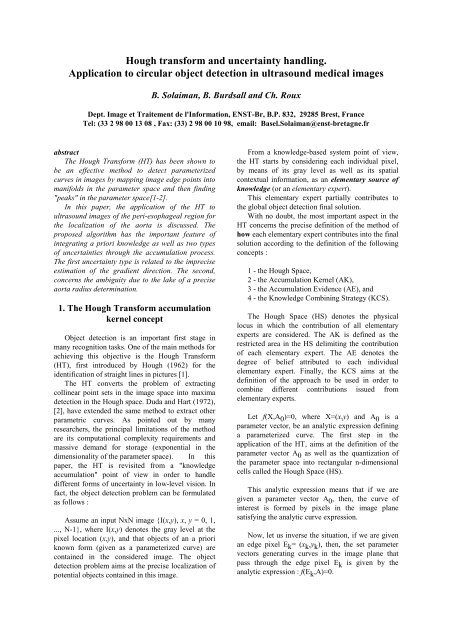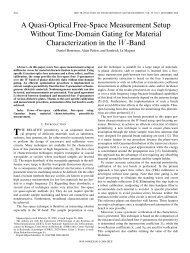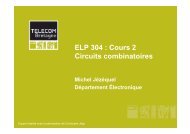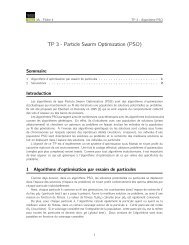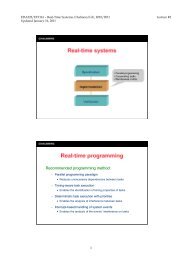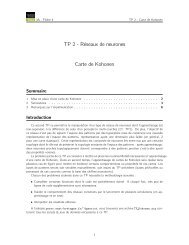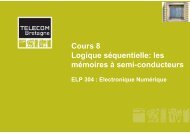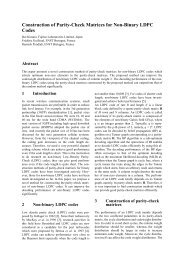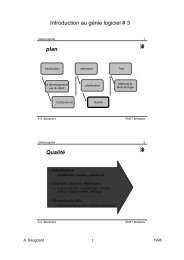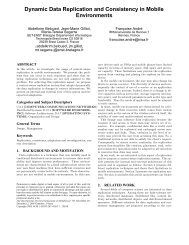Hough transform and uncertainty handling - Service d'echange de ...
Hough transform and uncertainty handling - Service d'echange de ...
Hough transform and uncertainty handling - Service d'echange de ...
Create successful ePaper yourself
Turn your PDF publications into a flip-book with our unique Google optimized e-Paper software.
<strong>Hough</strong> <strong>transform</strong> <strong>and</strong> <strong>uncertainty</strong> h<strong>and</strong>ling.Application to circular object <strong>de</strong>tection in ultrasound medical imagesB. Solaiman, B. Burdsall <strong>and</strong> Ch. RouxDept. Image et Traitement <strong>de</strong> l'Information, ENST-Br, B.P. 832, 29285 Brest, FranceTel: (33 2 98 00 13 08 , Fax: (33) 2 98 00 10 98, email: Basel.Solaiman@enst-bretagne.frabstractThe <strong>Hough</strong> Transform (HT) has been shown tobe an effective method to <strong>de</strong>tect parameterizedcurves in images by mapping image edge points intomanifolds in the parameter space <strong>and</strong> then finding"peaks" in the parameter space[1-2].In this paper, the application of the HT toultrasound images of the peri-esophageal region forthe localization of the aorta is discussed. Theproposed algorithm has the important feature ofintegrating a priori knowledge as well as two typesof uncertainties through the accumulation process.The first <strong>uncertainty</strong> type is related to the impreciseestimation of the gradient direction. The second,concerns the ambiguity due to the lake of a preciseaorta radius <strong>de</strong>termination.1. The <strong>Hough</strong> Transform accumulationkernel conceptObject <strong>de</strong>tection is an important first stage inmany recognition tasks. One of the main methods forachieving this objective is the <strong>Hough</strong> Transform(HT), first introduced by <strong>Hough</strong> (1962) for thei<strong>de</strong>ntification of straight lines in pictures [1].The HT converts the problem of extractingcollinear point sets in the image space into maxima<strong>de</strong>tection in the <strong>Hough</strong> space. Duda <strong>and</strong> Hart (1972),[2], have exten<strong>de</strong>d the same method to extract otherparametric curves. As pointed out by manyresearchers, the principal limitations of the methodare its computational complexity requirements <strong>and</strong>massive <strong>de</strong>m<strong>and</strong> for storage (exponential in thedimensionality of the parameter space). In thispaper, the HT is revisited from a "knowledgeaccumulation" point of view in or<strong>de</strong>r to h<strong>and</strong>ledifferent forms of <strong>uncertainty</strong> in low-level vision. Infact, the object <strong>de</strong>tection problem can be formulatedas follows :Assume an input NxN image {I(x,y), x, y = 0, 1,..., N-1}, where I(x,y) <strong>de</strong>notes the gray level at thepixel location (x,y), <strong>and</strong> that objects of an a prioriknown form (given as a parameterized curve) arecontained in the consi<strong>de</strong>red image. The object<strong>de</strong>tection problem aims at the precise localization ofpotential objects contained in this image.From a knowledge-based system point of view,the HT starts by consi<strong>de</strong>ring each individual pixel,by means of its gray level as well as its spatialcontextual information, as an elementary source ofknowledge (or an elementary expert).This elementary expert partially contributes tothe global object <strong>de</strong>tection final solution.With no doubt, the most important aspect in theHT concerns the precise <strong>de</strong>finition of the method ofhow each elementary expert contributes into the finalsolution according to the <strong>de</strong>finition of the followingconcepts :1 - the <strong>Hough</strong> Space,2 - the Accumulation Kernel (AK),3 - the Accumulation Evi<strong>de</strong>nce (AE), <strong>and</strong>4 - the Knowledge Combining Strategy (KCS).The <strong>Hough</strong> Space (HS) <strong>de</strong>notes the physicallocus in which the contribution of all elementaryexperts are consi<strong>de</strong>red. The AK is <strong>de</strong>fined as therestricted area in the HS <strong>de</strong>limiting the contributionof each elementary expert. The AE <strong>de</strong>notes the<strong>de</strong>gree of belief attributed to each individualelementary expert. Finally, the KCS aims at the<strong>de</strong>finition of the approach to be used in or<strong>de</strong>r tocombine different contributions issued fromelementary experts.Let f(X,A 0 )=0, where X=(x,y) <strong>and</strong> A 0 is aparameter vector, be an analytic expression <strong>de</strong>fininga parameterized curve. The first step in theapplication of the HT, aims at the <strong>de</strong>finition of theparameter vector A 0 as well as the quantization ofthe parameter space into rectangular n-dimensionalcells called the <strong>Hough</strong> Space (HS).This analytic expression means that if we aregiven a parameter vector A 0 , then, the curve ofinterest is formed by pixels in the image planesatisfying the analytic curve expression.Now, let us inverse the situation, if we are givenan edge pixel E k = (x k ,y k ), then, the set parametervectors generating curves in the image plane thatpass through the edge pixel E k is given by theanalytic expression : f(E k ,A)=0.
The locus of these vectors in the HS is called theAccumulation Kernel (AK). For instance, if the slop<strong>and</strong> intercept parameterization of straight lines isadopted (i.e; y=a 0 x+b 0 ) then the AK associated tothe edge pixel E k =(x k ,y k ), referred to as AK k , is astraight line in the HS (i.e; b= - ax k +y k ).Also, in the case of a fixed radius circle <strong>de</strong>tection(i.e; (x-a) 2 +(y-b) 2 =R 2 ), the AK k is a circle of radiusR centred on the edge pixel E k (i.e; (a-x k ) 2 + (b-y k ) 2= R 2 ).In this study, the concept of the AK is shown tobe of great interest when <strong>de</strong>aling with different typesof uncertainties. The fixed radius circular object<strong>de</strong>tection <strong>and</strong> localization is particularlyinvestigated.The second step in the application of the HT,concerns the edge pixels <strong>de</strong>tection. This is generallyconducted by applying an edge <strong>de</strong>tector to theimage. The set of potential edge pixels (E) is formedby those having a gradient magnitu<strong>de</strong> exceedingsome threshold "α":E ={X i,j such that g i,j >α}={E k = (x k , y k , g k , ϕ k ), k=1, 2, ..., K}.Therefore, each edge point E k , is associated withfour information elements, the pixel position (x k ,y k ),the gradient magnitu<strong>de</strong> g k , <strong>and</strong> the gradient directionϕ k . After these preliminary steps, the accumulationprocedure is the most important step in theapplication of the HT.In the st<strong>and</strong>ard HT <strong>and</strong> for each edge pixel E k ,all the cells situated on the AK k are incremented byunity. This value is called the accumulationevi<strong>de</strong>nce.In this study, we refer to this incrementationprocedure as the Total Ignorance Accumulation,meaning that if the edge pixel position is the onlyinformation used E k =(x k ,y k ), then no incrementationpreference is given to any accumulation cell on theAK k .Ballard has proposed [3] to use the gradientmagnitu<strong>de</strong>, g k , as a heuristic in the incrementationprocess. Instead of incrementing the AK k cells byunity, they are incremented by an accumulationevi<strong>de</strong>nce which is a function of the gradientmagnitu<strong>de</strong>.Now, if we assume that the gradient directioninformation, ϕ k , is precise <strong>and</strong> reliable, then onlyone cell on the AK k needs to be incremented. Thissituation is referred to as the Total KnowledgeAccumulation.Kimme et al. have proposed [4] an intermediateaccumulation procedure by consi<strong>de</strong>ring theimprecise nature of the gradient direction<strong>de</strong>termination. In the case of a circle <strong>de</strong>tection, onlythe cells situated on an arc in the direction of ϕ k <strong>and</strong>centred on (x k ,y k ) are incremented.In this study, the <strong>uncertainty</strong> concerning thecircle radius value is integrated to the imprecisedirection knowledge. This <strong>uncertainty</strong> is due eitherto the lake of the precise radius value knowledge, or,to the fact that the searched shape is "a nearlycircular shape" where the radius is <strong>de</strong>fined as arange of values instead of a single value.In this case, the accumulation kernel becomes asurface <strong>and</strong> not a linear curve, figure 1.In the case of Imprecise Direction-Radiusaccumulation, the accumulation evi<strong>de</strong>nce is a<strong>de</strong>creasing function of the parameter |ϕ−ϕ k | where ϕ∈[ϕ k -∆(r), ϕ k +∆(r)], figure 2.As the <strong>uncertainty</strong> in the direction increases, withan increasing radius, the accumulation kernel spreadsout in a radial fashion.Notice that the accumulation evi<strong>de</strong>nce is equal tounity for ϕ=ϕ k <strong>and</strong> for all r ∈[R 1 ,R 2 ]. This situationreflects the total imprecision concerning the realradius value.Otherwise, this accumulation evi<strong>de</strong>nce can beselected as a bell shaped function of the parameter r<strong>and</strong> centred on the radius R. The optimal radius,R Opt , of the circular form can be accurately<strong>de</strong>termined by a use of a simple 1D accumulator orhistogram of possible radii.For each edge pixel having a normal vectorpointing in the direction of the circle centre (x 0 ,y 0 ),the distance to (x 0 ,y 0 ) is measured <strong>and</strong> is stored inthe histogram (subject to the distance being within[R 1 ,R 2 ]). At the end of this accumulation, the mo<strong>de</strong>or peak, of the histogram represents the most likelyradius, figure 3.This "selective" radius <strong>de</strong>termination aims atreducing noise effects as well as at optimaloverlapped circles "discrimination".2. The Aorta <strong>de</strong>tectionIn this study, the proposed approach is applied inthe aorta <strong>de</strong>tection using echoendoscopic imagingsystems. Echoendoscopic imaging using ultrasoundis a technique encountered more <strong>and</strong> more often dueto its passive, unobtrusive, nature <strong>and</strong> subsequentlow risk to the patient. The visualization of theesophagus <strong>and</strong> peri-esophageal region provi<strong>de</strong>simportant diagnostic information about the onset <strong>and</strong>evolution of esophageal tumors, figure 4-a. Thetumors form in the esophageal wall, <strong>and</strong> spread
outwards to the surrounding organs (e.g. the aorta<strong>and</strong> ganglions).Echoendoscopic image interpretation iscompoun<strong>de</strong>d by two types of noise, or interference,during the data acquisition which <strong>de</strong>gra<strong>de</strong> theensuing visualization: Speckle noise results from thediffraction of the ultrasound by micro-anatomicstructures which have a size comparable to that ofthe wavelength.Bright harmonics are superimposed around thecentre of the esophagus. All these factors contributeto make the interpretation of ultrasound images verydifficult, even for trained medical specialists.3. Simulation results <strong>and</strong> furthercommentsThe aim of this study is the application of theproposed HT in or<strong>de</strong>r to have a precise <strong>de</strong>tection <strong>and</strong>localization of the aorta. The use of a priori anatomicknowledge of the approximate radius of the aorta hasalready been discussed in the previous section.A priori information concerning the approximateaorta position in the image plane is simply integratedthrough the use of a weight function, in the <strong>Hough</strong>space, assuming the value zero in areas where theaorta is not allowed to be <strong>de</strong>tected (central part ofthe image), <strong>and</strong> unity in the rest of the image.Finally, the Canny-Deriche edge <strong>de</strong>tector is usedbecause it allows the accurate estimation of thenormal vectors, <strong>and</strong> thus, increasing the efficiency ofthe accumulation.Obtained results in terms of <strong>de</strong>tection <strong>and</strong>localization of the aorta are extremely promising <strong>and</strong>clearly show the robustness of the proposedapproach on even quite noisy ultrasound images.Two examples of the obtained results are given infigure4.Figure 4-a shows an echoendoscopic image of a"normal" patient. On the other h<strong>and</strong>, Figure 4-bshows the aorta region concerning a patient havingan exten<strong>de</strong>d esophageal tumor leading to animportant <strong>de</strong>gradation of the esophagus <strong>and</strong> the aortawalls.In both cases, the resulting circularapproximation of the aorta is of high precision.Tested against the traditional <strong>Hough</strong> <strong>transform</strong>, theproposed approach leads to an important false alarmsreduction. Future work will concentrate on extendingthe use this approach to “elliptical” <strong>Hough</strong><strong>transform</strong>s in or<strong>de</strong>r to <strong>de</strong>tect such structures like theganglions. The integration of anatomical knowledgewill be integrated to reduce the search space. Theuse of snake algorithms is also studied to make themo<strong>de</strong>ls <strong>de</strong>formable for generalized shape <strong>de</strong>tection<strong>and</strong> for individual mo<strong>de</strong>lling to the patient.References[1] P.V.C. <strong>Hough</strong>, "Methods <strong>and</strong> means forrecognizing complex patterns," U.S. Patent 3,069,654, 1962.[2] R.O.Duda <strong>and</strong> P.E.Hart,"Using the <strong>Hough</strong><strong>transform</strong>s to <strong>de</strong>tect lines <strong>and</strong> curves in pictures,"Comm. of the ACM, 15(1), pp. 11-15, 1972.[3] D.H.Ballard,"Generalizing the <strong>Hough</strong> <strong>transform</strong>to <strong>de</strong>tect arbitrary shapes", Pattern Recognition13(2), pp. 111-122, 1981.[4] C.Kimme, D.Ballard <strong>and</strong> J.Sklanski,"Findingcircles by an array of accumulators," Comm. ACM18, pp. 120-122, 1975.ϕ k + ∆ϕ kE kRϕ k + ∆Rϕ kϕ k − ∆REdge pixel EkE kRϕ kϕ k− ∆EkRR maxmin(a) (b) (c) (d)a)Total Ignorance Accumulation, b) Total Knowledge Accumulation, c) ImpreciseDirection, accumulation <strong>and</strong> d) Imprecise Direction-Radius Accumulation.Figure 1. Circular Accumulation kernels associated with an edge point
1r = constantϕ − ∆kϕ kϕ + ∆kFigure 2. Accumulation evi<strong>de</strong>nce associated with E k . r∈[R 1 , R 2 ] <strong>and</strong> ϕ∈[ϕk -∆,ϕk +∆]ϕyR2R1y 0rx 0xR 1R OptR 2Figure 3, Selective radius accumulation process(a)Figure 4; Aorta localization using the modified <strong>Hough</strong> <strong>transform</strong>(b)


